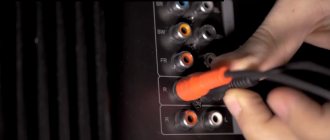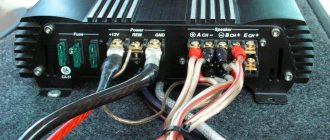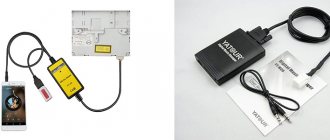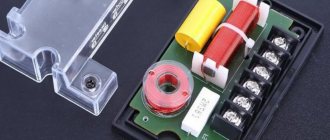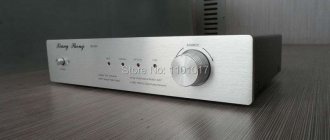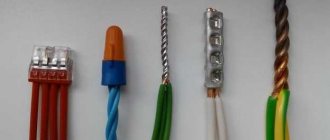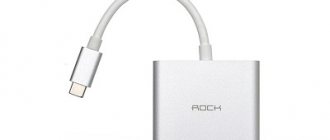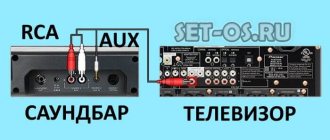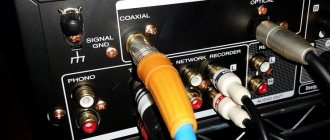What is a Coaxial connector on a TV?
Modern televisions have a number of connectors that differ in purpose to ensure the use of a wide variety of television signal sources. A variety of connectors is necessary to expand the compatibility of equipment of different generations and from different manufacturers.
Today, the technology of using communication connectors is gradually dying out, but due to the demand, some Internet providers and cable TV operators continue to use networks partially based on such devices. The purpose of a coaxial (from the English coaxial) connector for a TV will be described in this article.
Description of coaxial acoustics
Here, one design combines more than two speakers. Typically, one speaker with a low frequency is installed, and from one to three high-frequency devices are placed on it. There are models with the addition of mid-frequency speakers. But they are more expensive.
Acoustic speakers
Speakers
Why is there a communication jack on a TV?
The word coaxial, translated from Latin, literally means “shared axis,” and the definition of “coaxial” rather refers to a cable whose device ensures high-quality transmission of a high-frequency television signal from the antenna to the TV. That is, the communication connector is the output from the television receiver for connecting an antenna.
The main purpose of coaxial devices is to provide connections between different types of equipment. This connection has two types of paired components: socket-plug and pin-socket. Each cable corresponds to different types of communication outputs.
According to their functional purpose, the following types of connectors are distinguished:
Due to the high cost of copper structures of main communication cables, they are often replaced by optical analogues. They reduce the cost of production due to partial replacement of copper components. The base is made of steel, partially contains clad copper, and is braided with steel and aluminum wires on top.
Based on the assembly method, there are three groups of cable connectors:
Screw-on connectors
The body of the screw-on coaxial output has a built-in rounded thread and is complemented by a press-on nut.
This type of connection connector is also called a screw-on connector. It is especially widely used at home and is very popular due to the ease of connection, the implementation of which does not require special skills or special tools.
However, such common plugs have a number of significant disadvantages:
Crimp connectors
The crimping device uses two cylinders: an outer one, which seems to continue the structure of the housing, and an inner one, which is selected according to the diameter of the cable dielectric with foil. The circular symmetry of the cable is not broken during shrinkage of the outlet. Its body is pressed into a hexagonal prism using a crimping tool.
The antenna crimp connector also features a simplified mounting method.
The characteristics of such connectors may deteriorate due to the use of low-quality materials for their production, as a result of which they quickly wear out.
Compression connectors
The positive properties of compression coaxial outlets with the complexity of their design fully compensate for their relative high cost. They are considered the most reliable, but connecting to them requires understanding the specifics of fastening and the use of special devices.
The advantages of this type of coaxial connectors include:
Differences in design
The design is simple. A component system consists of several components. As a rule, these are two types of separate speakers: high-frequency speakers, called tweeters, and full-range speakers, which are responsible for the mid and high frequencies. There are also three-component acoustics - they additionally have a mid-frequency speaker.
Coaxial speakers have both a tweeter and a full-range driver built into one common housing. There are both three and four-way coaxial speakers, but they are all assembled into a single whole.
In both coaxial and component acoustics, different speakers reproduce different sets of frequencies, only in the first these speakers are mounted in a single device, and in the second they consist of several components. The meaning of this division is obvious, because the narrower the frequency band that the amplifier “feeds” to it, the less it is loaded, and the cleaner and better quality it reproduces the intended range.
In order for the car radio to present each of the speakers with frequencies intended specifically for it, a crossover is used. It is most often built into a coaxial system, and it is a fairly simple design - often it is an ordinary capacitor.
In component acoustics, a crossover is a separate device, which is often of better quality than the built-in one; at a minimum, it will have overload protection. Advanced models provide greater opportunities. For example, they allow you to correct differences in the distance from the speaker to the listener - because the driver is not sitting centrally in the car. To compensate for this, some crossovers have a switch that allows you to reduce the volume of one side by 1-2 dB. Top models can also adjust the phase and other specific options that allow you to adjust the sound of the audio system.
Often the speakers of component acoustics are so powerful that a conventional car radio cannot cope with them - the sound wheezes. In this case, you will need a separate amplifier. If the amplifier has a sufficient number of filters and channels, then you can connect component speakers to it without a crossover. For example, you can connect four speakers to a four-channel amplifier at once, each channel will amplify its own.
The speakers must be very accurately matched to the amplifier, since they can burn out due to differences in resistance or incorrect filter cutoff settings. What complicates matters is that the values are different for each model.
However, if the amplifier is advanced enough and has the necessary settings, or if there is an audio processor, great opportunities open up. For example, you can fully control the filters, that is, adjust the frequency ranges that are fed to the speakers. You can also control the filter slope and time delays to even more accurately compensate for differences in the distance of the speakers from the listener. An experienced auto mechanic can very accurately adjust the sound stage, creating the feeling that the sound source is not to the side, but in front of the driver.
Separately, it is worth mentioning the subwoofer. It reproduces sub-bass from 20 to 80 Hz - speakers with a diameter of less than 8 inches do not cope well with such frequencies. You can connect a subwoofer in addition to both a coaxial and component system.
Active subwoofers already have a built-in amplifier; they can simply be connected to the radio, but for this the radio must have at least three linear stereo outputs. A passive subwoofer generally requires a separate amplifier.
Special adapters
To solve problems associated with the placement of cable connections, as well as telecommunications equipment at different levels of modern structures within the framework of compliance with certain standard requirements, special adapters are used - RF connector adapters.
Different sections of modern highways place their own demands on the equipment, therefore, depending on special needs, both professional types of communication outputs and conventional plugs are widely used.
When choosing an antenna connector and a cable for it, in addition to taking into account the above, you should pay attention to the main property of a coaxial cable - a resistance of 75 Ohms, which is indicated on the insulation.
When purchasing a communication cable for independent installation and connection, you should do so with a reserve length, since the necessary preparation for its installation may require more than one attempt, using up a small part of it.
Source
Coaxial speaker system
The layout of the speakers on one axis involves certain technical difficulties in the manufacture of speakers. The main thing in coaxial speakers is the reliable and durable installation of dynamic satellite heads, which are located above the woofer. Bass frequencies, especially with a high-power low-frequency amplifier, can disrupt the installation panel and damage the speakers themselves. Therefore, with a very large ULF output, it is better to use a component design rather than coaxial speakers.
What is a coaxial connector on a TV?
Some cable TV operators and Internet providers still use networks, some of which are based on coaxial connectors or devices. This technology is becoming a thing of the past, but in some cases it is still in demand.
The main purpose of using coaxial is to provide a connection between a cable or the latter with various types of equipment. The connection itself has main components - a pair of two types:
A cable of a specific group is usually correlated with the connectors of the whole set. The division into several types is based on the connection used and functions.
RG6/RG11 – outputs for distribution or subscriber cables, the relevance of which remains, and even increases every year.
Attention! Increasingly, main coaxial cables are being replaced with optical analogues. The high price of copper structures also leads to a decrease in their use in various fields.
The central steel core is the main component for coaxial cables. In addition, the use of clad copper, two types of braiding is typical - wire on steel, aluminum. Thanks to such materials, production becomes cheaper. But simple soldering for products is impossible; tinning does not occur completely. Connections are ensured through mechanical contact; this is an option for obtaining better results during further work.
Cable outlets are divided into several groups depending on the installation method:
About screw-on connectors
In this case, the basis of the design is the body, along with a rounded built-in thread. The product is complemented by a press-on nut for F-standard.
Such connectors have certain disadvantages:
Crimp connectors
Here we are talking about using two cylinders. There is an external one - it seems to continue the structure of the body. The internal one is selected depending on the diameter of the cable dielectric with foil. When the connector is placed on the cables, the circular symmetry of the latter is not broken. The outside of the housing requires crimping into a prism with six edges using a crimping tool.
Reference! The main disadvantage is related to the material used in production. If the design is not of good quality, the body collapses too quickly. Because of this, the connection characteristics also deteriorate.
Sound Quality Difference
In terms of sound quality, component acoustics in car audio outperform coaxial ones. And the reason is not in the design itself, not in the crossovers, or even in the accuracy of their settings. Proof of this is the fact that coaxial speakers were originally used in hi-fi equipment - they were first introduced by Tannoy back in 1947. This company was so popular among audiophiles of that time that any Hi-Fi acoustics were often called “tannoys”. The main advantage of the new product is the absence of phase shifts when operating the high-frequency and mid-frequency speakers. The sound comes from one point, so the comfortable listening area is clearer. Coaxial acoustics are still widely used in professional audio equipment - studio monitors, portals, etc.
But what is a plus for studio and home Hi-Fi systems becomes a minus for car audio. This is explained quite simply: coaxial speakers mounted in the door emit sound not towards the listener’s ears. This means that the high frequencies, which are emitted by the tweeter quite closely and directionally, will be picked up by the ear only after their multiple reflections from the elements of the car’s interior. So the sound becomes blurry, inaccurate and dull. Although some models are equipped with rotating tweeters, this does not really help.
Proper speaker placement is one of the key factors for getting good sound.
It doesn't matter how much an audio system and its components cost if the speakers aren't aimed at the listener. The ability to position the speakers correctly is the key benefit of a component audio system. For example, the tweeters will be installed at ear level and facing the listener. As a rule, they are mounted in the corners of mirrors or in windshield pillars. This is the only way to get the highest quality sound.
The sound propagation angle in mid-range speakers is larger, so there is no problem if they are installed in doors. But still, for maximum quality and better detail, the midrange is directed towards the listener, for which a special podium is constructed in the door. The obvious disadvantage of this design is the complexity of installation. Modification of the car body will be required.
About special adapters
Switching with already ringed cables is a characteristic feature of modern offices. At different levels there are cable connections and telecommunications equipment. In this regard, problems arise with space for bending structures and compliance with certain standards. RF connector adapters are special adapters, the use of which allows you to solve the problem.
Every outlet on the modern market is created to solve a problem. Inexpensive varieties with simple threaded connections can work normally on individual subscriber telephone lines. But this does not mean that the same equipment will cope with particularly important sections of cable networks. You will need to purchase professional types of connectors, crimp or compression. Each section of the highway has its own requirements for equipment.
Source
How to install a sound system
Coaxial devices are located in the rear parts of the cabin. On rear shelves or doors. Simpler options are installed in panels at the front. But you need to understand that it is not recommended to overload the front panels. If you want to connect sound to the front of the car, the elements are mounted in the front doors.
The best coaxial acoustics should please not only the driver, but also the passengers. Therefore, the quality of the system is very important. Setting up effective sound is easy. And many do the work themselves. There is no need to carry out complex calculations or make special podiums. This does not affect the sound quality.
It is important to know that all elements must be firmly fixed. To avoid their failure when moving and shaking. Experienced drivers know that there are special places in the cabin where acoustics are needed.
Installation and connection of all acoustic components
By following the following recommendations, you can handle the installation without difficulty.
Types and functions of TV connectors
The wireless connection method is becoming increasingly popular in the modern world, but there are often cases when it is not possible to do without wires. This is especially true for audio and video equipment. TV connectors are presented in a large number of types. Some are known to everyone, as they are used by every user, others are rarely used, which raises the question of what they are needed for. Wired TV interfaces and their purposes are described below.
Difference in installation
The undoubted advantage of coaxial speakers is their ease of installation in a car. A pair of such speakers can be easily mounted in the doors or in the luggage compartment shelf - in the standard places provided by the design of the car. Professionals advise installing them in the rear doors, since when installed in the front doors, the high frequencies will be almost inaudible due to the narrow focus of the tweeters.
To equip a car with coaxial acoustics, you only need a pair of speakers, wires and a car radio of sufficient power. All that remains is to mount and connect - the system is ready!
Popular connectors
All TV connectors can be divided into popular and not so popular. To begin with, it makes sense to consider those that are used most often than others.
Composite
Hearing the word “composite input”, many users will be perplexed, but if they call it tulips or AV output, then more understanding will appear. All these are names for one interface, which serves to transmit analog audio and video signals. The AV input on a TV is a combination of three connectors: yellow (responsible for video), white and red (transmit the right and left audio channels).
The composite input is used to connect old satellite or digital set-top boxes, DVD players, game consoles, and video cameras. The input is still used and is often found in modern models, but it is still a “dying” type, since it is impossible to transmit high-quality content through it.
This interface has been the most popular in recent years. It can be found not only in TV, but also in many types of technology. Digital video and audio signals are transmitted via HDMI. Currently it provides the best quality (among the connections used) - 4K with 60 FPS and multi-channel audio up to 12.1.
Through this connector you can connect almost any device - game consoles, tuners, receivers, PCs, laptops, sound bar or home theater, as well as smartphones and tablets (they use mini or microHDMI). HDMI outputs may differ in generation, for example, 1.4, 2.0, 2.1. The maximum quality of the transmitted signal depends on this; for example, 1.4 is not designed for UHD.
USB is an interface for data transfer. It can serve for different purposes, but on a TV it is needed to connect external storage media, as well as a mouse, keyboard, and gamepad. May differ in class - 2.0 or 3.0. The second provides a higher information transfer speed, so it is recommended to connect drives to it, and input devices to USB 2.0.
RF (antenna)
Antenna connector, RF, ANT IN, coaxial output is necessary to connect a television antenna, as is clear from the name. It transmits an analog signal. This input has a large number of varieties, but TVs use 2: a regular antenna is inserted into the first, satellite antennas or cable TV are connected into the second. The second one can be labeled Cabel In, it differs in that it has a thread - that is, there is an attachment on the antenna that is screwed onto this input.
Coaxial connector comes in different types - it can be threaded or female. You can transmit different types of analog signals through it - video or audio. In older devices, it was used not only for video, but also for audio, that is, there was Coaxial In (an antenna or VHS player was connected), and Coaxial Out served to connect an amplifier and speakers through it. In modern TVs, a coaxial input means an antenna connection for video, but not sound!
LAN (Ethernet)
LAN is a connector for connecting a fiber optic RJ-45 Internet cable. It can be on a TV, even if the latter does not have an Internet mode. In this case, it is used to update the TV’s firmware or provide remote access to diagnose and repair the device’s software. Such services are provided by famous brands - Samsung, Sony and others.
Audio output (3.5)
On modern TVs, the familiar 3.5 (mini jack) can be found in 50% of cases, and this situation is observed even within the same manufacturer. As a rule, inexpensive TVs have a solution. It is secretly called PC Audio output, since it is used to connect simple audio systems - PC speakers or headphones.
Optics (S\PDIF)
Before the advent of HDMI, audio connoisseurs used this connector to transmit high-quality multi-channel audio. The optical input transmits sound without distortion . It may have been supplanted by HDMI, but manufacturers of expensive home theaters equip their equipment with an optical output, believing that it has a higher signal quality, so TV manufacturers are forced to use it.
PCMCIA/Express Card/CI+
Not all TVs have this slot (the only brand that has equipped all devices with a slot for a conditional access module since 2022 is LG), but it is relevant in 2022. Used to connect an adapter to a smart card on TVs with built-in DVB-C and S2 tuners.
Pioneer wideband speakers
The system is also easy to install and connect. The sound is not distorted at any power. With all its qualities, the price of the equipment is low and the design of the speakers is stylish.
For many, it is not only the quality of sounds that matters, but also the volume limits. For example, if people like to listen to songs in nature. Such users prefer to choose powerful equipment. And it is Pioneer that is best suited for them.
Pioneer wideband speakers
Since 16 cm speakers have many advantages:
- They tolerate powerful overloads well;
- small sizes;
- the sound is deeper than that of 13 or 20 centimeter analogues;
- the best system in terms of quality indicators.
The TRS standard is one of the oldest and time-tested, since it was first used at the dawn of the design of telephone switches in the 19th century. Initially, the TRS connector had a simplified TS design (there was no additional ring channel). The essence of the abbreviation itself is as follows:
The design of the TRS plug fully justifies its components: a pointed sleeve with plastic insulating partitions separating the channels. The generally accepted standard for a TRS plug and, accordingly, a port is a traditional stereo jack, which has three contacts: left and right channels + ground.
There are three sizes of TRS audio connectors:
- 6.3 mm jack (1/4 inch). Used in professional musical equipment: from mixers and sound cards, to microphones and musical power instruments.
- 3.5 mm jack. A universal audio output that is used in consumer electronics and portable equipment of any level.
- 2.5 mm jack. A standard that is gradually becoming a thing of the past. Scope of application: portable equipment, tuners, headphone cup connection ports with detachable cords.
How to listen: Connecting via TRS is the simplest: it’s easy to choose the appropriate adapter for any size of port and plug, but the main enemy of cheapness remains physics. Don’t expect “super sound” and the laurels of “reference vinyl” from TRS.
Rare connectors
This category includes inputs and outputs that are either already outdated and almost never used in TV, or are new, and therefore have not yet become widespread.
Component (YPbPr)
Sometimes, looking at the back panel of the TV in search of the usual tulips, users see a similar output, but painted in different colors (blue, red, green) and labeled Component in. YPbPr is a digital video input capable of transmitting images in high quality (FHD). It is considered obsolete, as it was replaced by HDMI, which also transmits a digital signal, but in higher quality.
Accordingly, additional white and red inputs are the right and left audio channels.
Used to connect DVD players, game consoles or home theaters.
S-Video
An outdated video connector for transmitting an analog signal. Although the signal is split like a component jack, only one wire is used for the connection. Used in old DVD players and satellite dish receivers.
Provides input and output of digital or analog video signal. The output is quite outdated and is almost never used in modern TVs. It allows you to connect a PC or laptop to it so that the TV acts as a monitor. This connector is still found in computers, but the connection to the TV is usually made through a DVI to HDMI adapter.
Another video output that allows you to use the TV as a monitor. Unlike DVI , it transmits exclusively analog images . Despite the fact that the VGA input is conditionally worse, it is more widespread, but mainly on cheap or Chinese TVs.
SCART
The SCART connector is an obsolete type. It can transmit analog and digital video signals, but due to limited bandwidth it was replaced by HDMI. Very rare in modern technology. At the time of its use, it was widely used for DVD players and set-top boxes for satellite dishes.
The connector visually looks like HDMI and performs a similar function - transmitting digital audio and video signals. The difference is that it is designed for connecting mobile devices and combines the features of microUSB, namely, during the connection process it not only receives a picture from the smartphone, but also charges it. This is a very rare type of connector, and it is most often found in Samsung.
Which is better, component or coaxial acoustics?
The main advantage of a coaxial speaker system is its small dimensions. Therefore, the use of coaxial speakers is justified where the size of the speakers plays an important role. First of all, this applies to car acoustics. Which is better: component or coaxial speakers? The vehicle's audio output devices are mounted in the doors, front panel or seat backs. In these cases, it will not be possible to use component cabinet speakers due to limited space and the configuration of the vehicle elements. Therefore, vehicles are equipped with coaxial cables designed for two or three audio frequency bands. Such speaker systems are easily mounted in seats on car doors.
Connectors of the future
New technologies come to PCs faster than to TVs. In this section we will look at two super modern and functionally charged connectors, which are not yet on TV, but have a great future.
USB 3.1, USB-C, Type-C is the new version of USB. It received the 3.1 marking, which means “older generation” and is different in appearance - you don’t need to look at which side to insert the plug into. It provides faster connection speed. This connector is not yet used on TVs, but in the next couple of years we can expect a widespread transition to it instead of regular USB.
Thunderbolt 3
The output is USB-C compatible, meaning it looks similar but has a number of advantages. It is input/output, provides the highest data transfer speed (up to 40 Gbps), high quality video (5 K ) and audio signal, and at the same time is capable of powering equipment (up to 100 W). In fact, with one cable via Thunderbolt 3 you can transmit picture, sound and power the device. In this case, the equipment can be connected in series through one input - for example, a monitor is connected from a PC, and another monitor is connected to it. In this case, both screens may not be additionally connected to the electrical network.
This type of connection has appeared recently. It was developed by Intel. It is currently distributed in PCs, monitors and laptops, but in the foreseeable future it will become a logical replacement for HDMI and USB connectors, so you should expect it to appear on TVs as well.
Source
Balanced output
In the field of professional audio equipment, one of the reference connection options is balanced. Externally, it is not much different from a wide-profile TRS, but its operating algorithm allows you to achieve noticeably better sound quality.
With a balanced connection (symmetrical), the signal passes through three conductors: two information channels (direct and reverse) and ground. Thus, the electrical impedance between the conductors is balanced because it is supplied in antiphase. The result: a significant increase in the power of the useful signal and minimization of interference.
Coaxial, optical and HDMI: which type of connections should you prefer?
Save and read later -
You have already studied the connectors and bought all the necessary cables. All that remains is to decide which digital audio channel to use. Which option will provide optimal audio and video playback? Our brief overview will help you figure it out.
If you've ever owned a TV, DVD player, set-top box or soundbar, you've probably already had experience with coaxial or optical connectors, and in recent years, HDMI ports.
All three types of connections are digital. Coaxial and optical cables can only transmit audio signals; HDMI supports both audio and video simultaneously. If you don't have a clear idea of which connector to choose, read our material.
Types of sound systems
There are two types: coaxial and component. To make a choice, you need to have an idea about each option. Compare quality, read reviews.
Sound speakers
Component installation allows you to connect multiple speakers. For example, you can buy 2-3 with low frequency and the same number with medium frequency.
High-frequency heads must be placed separately. The package includes crossovers that separate audio signals. This option is suitable for lovers of loud music and has better sound quality. But it costs more and takes up more space inside the cabin.
The coaxial design is distinguished by its compactness and spaciousness. But it’s up to the user to decide whether he prefers coaxial or component acoustics.
Kicx Coaxial Speaker System
Coaxial digital connection
Perhaps the rarest type of connection in modern audio and video components, coaxial, involves the use of electricity to transmit the audio signal.
The corresponding connector is a familiar round RCA plug that terminates a pair of analog interconnect cables on both sides.
But don't be tempted to use a standard analog RCA cable instead of a dedicated digital coaxial cable! It looks similar and is even quite functional, but its characteristic impedance is lower than that of a digital one (50 and 75 Ohms, respectively), so you won’t get good results. For most systems, an entry-level cable such as QED Performance Coaxial will do just fine.
Today, coaxial connections are less common than optical ones, but they can still be found on the back panels of some AV receivers, amplifiers and televisions.
In our experience, compared to optical, coaxial connections generally provide better sound. It has higher bandwidth, which supports higher quality file formats with up to 24-bit/192 kHz sampling. The optical channel is usually limited to 96 kHz.
The main disadvantage of a coaxial connection is the potential for electrical noise to be carried between devices in the system. It always reduces sound quality and is present to varying degrees in all components. Unfortunately, when using a coaxial connection, noise can be transmitted from the source to the amplifier.
In addition, coaxial cable does not have enough bandwidth to carry high-quality surround sound formats such as Dolby TrueHD, DTS-HD Master Audio, Dolby Atmos and DTS:X. Therefore, the possibilities of its use in a modern home theater system are limited.
What is coaxial acoustics
Based on their design, sound speakers are divided into two groups: component acoustics and coaxial systems. The difference between component acoustics and coaxial acoustics lies in the way the speakers are installed. In a component system, speakers are typically arranged vertically. At the bottom of the case there is a low-frequency speaker, above it there is a mid-frequency emitter, and at the very top of the case there is a high-frequency head.
Component acoustics allows the use of low-frequency amplifiers of almost any power. The cabinet design allows the installation of not only three dynamic heads, but also more. To reduce the length of connecting wires, which negatively affects sound quality, crossover filters or crossovers are placed inside the speaker system, next to the speakers. Component speakers are not necessarily housed in a common enclosure. In some designs, frequency emitters are spaced throughout the room to create spatial sound and sound effects. This arrangement is used in multi-channel home theater amplifiers.
A coaxial speaker is a design where the speakers are mounted on the same axis. In the central part of the woofer, above the diffuser, there is a plastic plate on which small-sized dynamic heads are installed. Two-way coaxial acoustics consists of a low-frequency driver and a tweeter. A more advanced coaxial type sound speaker consists of three speakers and provides high-quality sound with sound separation into three bands.
Optical digital connection
In an optical digital connection, data is transmitted through a fiber optic cable (the fibers of which can be made of plastic, glass or quartz) using light. In this case, noise from the source is not transferred to the DAC circuit, as can happen with a coaxial one, so it is reasonable to use it when connecting the device directly to the DAC of a soundbar or AV receiver.
Traditionally, in DC systems, optical cables are used to transmit compressed multi-channel audio in Dolby Digital and DTS formats. Those with a Toslink connector (Toshiba Link) connect to the corresponding ports of the source and AV receiver. A good starting option is the QED Performance Graphite Optical cable.
Many manufacturers have moved to HDMI as the primary connector type, but optical outputs are still regularly found on devices such as game consoles, Blu-ray players, set-top boxes and televisions. The corresponding inputs can be found on the amplifier or DAC side - for example, in sound bars or AV receivers.
As with coaxial connections, one of the problems with optical connections is the lack of bandwidth to transmit lossless audio formats, such as Dolby TrueHD or DTS-HD Master Audio, which contain most soundtracks on Blu-ray discs. In addition, the optical connection is not capable of transmitting more than two uncompressed channels to the PCM. Finally, the optical cable can be damaged if it is bent too much.
What about HDMI?
The main advantage of the HDMI standard, introduced in 2002, is the ability to simultaneously transmit video and audio signals. It has significantly higher bandwidth than an optical connection, allowing you to transfer lossless audio files such as Dolby TrueHD and DTS-HD Master Audio. If optical and coaxial connections can be called competitors, then HDMI has no rivals.
HDMI inputs and outputs have long gained a strong position in TVs, Blu-ray players and AV receivers, and are also increasingly found in sound bars. An entry-level cable, such as the AudioQuest Pearl HDMI, will suit a wide range of systems.
The HDMI standard is constantly evolving, with new versions providing ever-widening bandwidth and increased throughput, allowing soundtracks to be transmitted with a greater number of audio channels - for example, in Dolby Atmos and DTS:X formats. It also supports existing and new video formats - including Ultra HD 4K resolution and various versions of HDR - as well as additional features such as high frame rate (HFR) and eARC (supporting up to 32 channels of audio).
Currently, the 2.0 standard is generally accepted, but HDMI 2.1 (supporting 8K content) is gradually making its way to the market.
